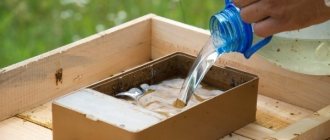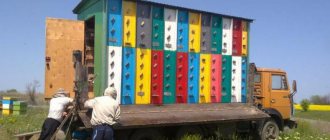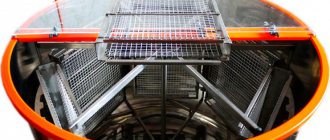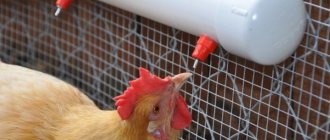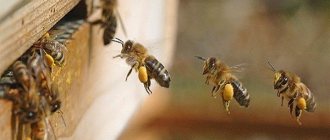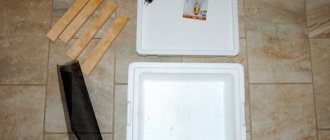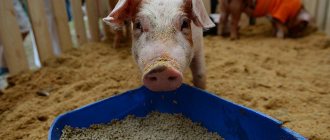Design Features
The Ukrainian hive is one of the most popular among beekeepers. Its structure is closest to the natural living conditions of bees, so they feel comfortable in it. The prototype of the Ukrainian hive was logs - houses for honey-bearing insects, which were made from logs by residents of Central Europe until the 19th century. The first beehive, which was later called Ukrainian, was made in the 1870s. Pole Kazimir Levitsky. Today, somewhat simplified designs are used.
A horizontal hive with a high frame is a simple rectangular structure containing from 16 to 24 frames. It has a roof and a bottom that cannot be removed. If necessary, it is separated by diaphragms and also additionally insulated. The main generally accepted frame dimensions are 435x300 mm.
Did you know? The domestication of bees occurred about 5-6 thousand years ago. People housed honey insects in primitive hives made of rods and boards, or in clay vessels.
- The design of the lounger has a number of advantages:
- ease of use;
- comfortable keeping of bees at any time of the year;
- minimal human intervention in the activities of honey insects;
- the possibility of keeping two bee families or one family with a nucleus in one hive;
- ease of making with your own hands;
- no additional extensions;
- one frame size.
- Among the disadvantages of the described design it is worth mentioning:
- Possibility of use only in small stationary apiaries;
- large dimensions;
- non-demountable design;
- inconvenience when staying in a winter shelter;
- insufficient air exchange during wintering;
- difficulties in growing families.
Drawings and dimensions
Many novice beekeepers cannot always buy the necessary hives, which is why they often think about making them themselves. And the main thing in this process will be the correct drawing and the exact indicated dimensions of the future bee house. It is best to choose drawings that have been verified on special beekeeping sites or from professionals. Not only the life of the bees, but also a good honey flow and honey harvest will then depend on the right hive.
We present to your attention a drawing with the dimensions of a Ukrainian hive-lounger
When building, be sure to take into account the exact dimensions of the hive. For example, the standard Ukrainian one has a body 686 mm long, 381 mm wide and 507 mm high. Don't forget about the wall thickness. The front and back must have at least 33 millimeters, the sides and bottom - 28 millimeters. The walls and bottom must be assembled separately, fastened with slats and glue. In the right wall there is an vent 115 millimeters high. Rebate – 6 by 16 millimeters. Detailed dimensions are indicated in the drawings.
Rules for keeping bees in Ukrainian hives
In hives with narrow frames, when keeping two families or a family with a nucleus, in the spring it is necessary to provide them with a lot of food - about 8-10 kg per family, and the nests should be well insulated with pillows, mats, and paper.
It is important to take measures to prevent members of one family from ending up in another. To do this, strong families are first released. After they return to the hive, the entrances are closed and members of the weak family are released for the spring flight.
The nest is expanded once. The expansion should be done at the time the queen lays eggs. The procedure is carried out with light brown honeycombs. If there are 7-8 combs of brood, all combs must be moved to the wall located on the opposite side of the entrance. The space that is freed up should be filled with frames with drying material and wax in an amount of at least 5 pieces. To restore the normal position of the nest, honey insects will build honeycombs on the foundation, and they will not have time to swarm. Newly built combs are placed closer to the center of the nest. Old honeycombs are gradually moved closer to the edges.
Important! Before inserting frames with drying material, it is necessary to wet them in warm water.
To avoid swarming, it is necessary to divide the nest into 2 halves with two or three frames of dry land. Noticing this, the queen will try to reunite the nest by filling the comb with eggs. When the honey yield level exceeds 2 kg, the hive is supplemented with an extension with 10–20 frames. When the nest becomes crowded, the family should be moved to a separate hive.
Keeping bees
It is important to note that the hive, called Ukrainian, has become popular due to the fact that workers in them tolerate winter well. Keeping bees takes less time and costs, especially in winter. In it, insects do not need to spend a lot of energy heating the room, so they never lack food. At the same time, honey, which is located in the upper layers of the frames, also creates a kind of “cushion”, accumulating heat. Also in such hives, honey collected in the spring is also compactly located in the upper parts of the frames.
Advice from experienced beekeepers
To make keeping bees in Ukrainian hives comfortable for both the owner and the insects, you should follow the recommendations of experienced beekeepers:
- Extend the expansion in 2-3 times: with 6-7 frames with brood, deliver 2 frames with honey and 2 with artificial foundation; after filling them, add 4-5 frames, 3 of which with foundation; if necessary, add the required number of frames before honey collection.
- Expanding the nest by dividing it into 2 parts should only be done in a strong family and in the absence of the threat of cold weather.
- Before the main honey collection, it is necessary to regroup the frames by concentrating all the frames with open brood and the queen near the entrance, and the combs with printed brood - in the depths of the nest.
- It is not necessary to equip hives with extensions if the colony begins to swarm and lays queen cells on the combs.
- To save labor during the late honey harvest, it is necessary to form a temporary layer. Formation is started after the family has grown 11-12 frames, 8-9 of which will be occupied by brood.
- To prevent swarming, you need to use various methods: assistant queens, the Chaikin method, loading the bees with work, etc.
So, Ukrainian hives are simple structures for keeping two bee colonies or one colony with a nucleus. They are easy to use for the beekeeper and comfortable for the bees to live in.
Did you know? The most ancient remains of a bee, which have been found by paleontologists today, date back to a period of 100 million years ago. They were dug up in Burma. The insect was a transitional form from the predator wasp to the pollinating bee.
How to make a Ukrainian beehive with your own hands
Having the desire and minimal experience in carpentry makes it possible to make a Levitsky hive yourself. In order to do this, prepare the following tools and materials (dimensions are in mm):
- boards (840 x 145 x 40) - 2 pcs.;
- boards (840 x 185 x 40) - 4 pcs.;
- boards (365 x 139 x 40) - 8 pcs.;
- boards (810 x 150 x 40) - 3 pcs.;
- board (400 x 70 x 30) - 1 pc.;
- boards (860 x 200 x 20) - 2 pcs.;
- boards (395 x 200 x 20) - 2 pcs.;
- roofing boards (960 x 130 x 15) - 4 pcs.;
- slats (840 x 30 x 13) - 8 pcs.;
- jigsaw and hacksaw;
- hammer and nails;
- plane and sandpaper;
- tongue and groove sheets and tongues.
Assemble the product as follows:
- From three boards, two 185 mm wide, one 145 mm wide, a façade wall is made using tongues.
- Cut a pair of lower entrance slots, 200 mm long and 10 mm high.
- Step back 12 mm from the top, drill the upper tap holes with a diameter of 25 mm. These tap holes are located as if between the lower holes, if you lower the perpendiculars.
- The back wall is assembled from wooden elements 840 x 185 x 40 mm. The assembled wall should be 40 mm wider than the end.
- Cut the bottom tap hole 4 cm above the bottom edge and 9 cm from the side. Taphole length - 100 mm, width 10 mm.
- Make sidewalls, each from four elements measuring 365 x 139 mm, and then assemble the entire body.
- Assemble the bottom from three boards 810 x 150 mm. Insert the bottom into the body, knock it down with nails, 4 pieces for each board. Excess and protruding parts are cut off and processed with sandpaper and a plane.
- Attach the arrival board, which also serves as a separator.
- Install guide bars along the upper edge of the tapholes and insert liners.
- Place the landing board on the hinges.
- Assemble the roof from the shield frame, cover it with galvanized iron, or rubber, roofing felt, etc.
- In the side elements of the trim, drill three ventilation holes with a diameter of 20 mm, cover them with grilles from the inside, and install valves on the outside.
Drawings and dimensions
Below are drawings of a Ukrainian sun lounger, the body dimensions of which are (in mm):
- length - 685;
- width - 381;
- height - 507;
- thickness of front and rear walls - 33;
- sides - 28.
Hive equipment inside
Inside the box on the front and rear walls, cut cuts 10 mm wide and 6 mm deep. Separators are installed in them.
Using a pressure strip, the required number of frames 300 x 435 mm are attached.
Advantages and disadvantages
Main advantages of the design:
- simple maintenance;
- possibility of placing up to 20 frames in internal cavities;
- protection of the internal volume from precipitation;
- suitability for wintering of a bee colony.
Equipment disadvantages:
- the product is stationary;
- frames and other parts are incompatible with hives of other designs;
- there are difficulties when expanding the horizontal socket;
- There is poor ventilation, which at the same time provides increased temperatures inside in winter.
The history of the Levitsky hive
The designer of the design, Kazimir Levitsky, was born in Poland in 1847. From a young age, he began breeding bees, while simultaneously developing new designs for hives and auxiliary equipment.
The inventor visited a number of countries in Central and Southern Europe, and in the early 1880s. organized an experimental apiary with a small museum, on which there were hives of an original design, called the Warsaw ones. The products were distinguished by increased strength, were equipped with folding sides and a roof and ensured heat retention in the winter.
The bee entrances were equipped with metal flaps that were closed for the winter. Wooden linings were provided on the inner surface of the side covers, increasing the mechanical strength of the parts.
An additional board was located under the entrance to protect the internal volume from wet snow. The outer part was partially covered with straw, and the wooden elements were covered with a layer of oil paint, which protected the wood from rotting.
Levitsky’s design was widely used in private beekeeping, but after its creation in the 30s. Since the last century of collective farms focused on producing honey on an industrial scale, the popularity of products has decreased.
Hives are used to a limited extent in small apiaries because they do not require regular and labor-intensive maintenance. Experienced beekeepers are confident that Levitsky’s scheme provides increased quality of honey thanks to elongated frames reminiscent of the honeycomb of wild bees.
Reviews
As they say, beekeeping is serious business. Analyzing the reviews, it is worth saying that every beekeeper chooses a home for his pets according to his taste. Some people like Ukrainian bee hives, others, of course, find shortcomings. And this is understandable. But for the most part, all users of these hives only talk about the positive qualities of their design. For example, many people like the possibility of placing two bee colonies in them, and also the fact that insects tolerate wintering well in it. Some talk about the inconvenience during migration, since these hives were originally invented for stationary housing of bees. In any case, the popularity of Ukrainian hives is justified and proven by their many years of use.
